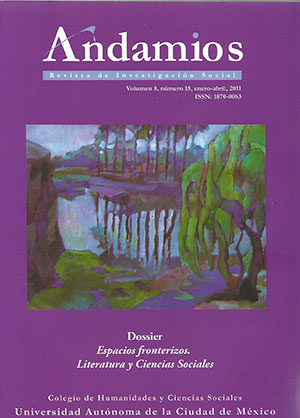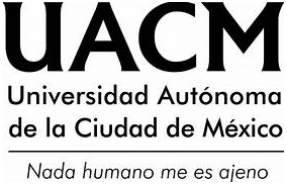FICTION AND REALITY IN EL PECADO DEL SIGLO BY JOSÉ TOMÁS DE CUÉLLAR
DOI:
https://doi.org/10.29092/uacm.v8i15.74Keywords:
Historical novel, José T de Cuéllar, república restaurada, literature, historyAbstract
This article reviews some historical elements that Jose Tomás de Cuéllar novelized in El pecado del siglo (1869), historical novel that narrates a famous crime, which happened one century behind in times of the Revillagigedo viceroy (1789). It ponders about the Colonia’s reading done by the República Restaurada writers, and explores the writer’s workshop: the sources in which Cuéllar documented the matter, the transformation of the information in literature and the items without historical references that he interweaves in the story. All this elements are provided, for the reader to understand his own historical moment.
Downloads
References
ALGABA, L. (1997), Las licencias del novelista y las máscaras del crítico, México: Universidad Autónoma Metropolitana (UAM)- Azcapotzalco.
ALTAMIRANO, I. M. (1868), Revistas literarias de México, México: Imprenta de Francisco Díaz de León y S. White.
__________ (1949), La literatura nacional, textos de crítica literaria sobre temas mexicanos, entre 1868 y 1883, I, México: Porrúa.
__________ (1987), Obras completas, VIII. Crónicas, 2, México: Secretaría de Educación Pública (SEP).
BAJTIN, M. (1989), Teoría y estética de la novela, Madrid: Taurus.
BUSTAMANTE, C. M. de (1835), “Memorial ajustado de la causa que se formó a Aldama, Blanco y Quintero por los homicidios que perpetraron en la persona de don Joaquín Dongo y diez fa- miliares suyos, y relación de todo cuanto ocurrió en el término de quince días que intermediaron desde la muerte de éstos, y el castigo de los malhechores”, en Efemérides históricopolítico literarias, México: Imprenta de la Testamentaría de Valdés, 33 pp.
CUÉLLAR, J. T. de (2007) [1869], Obras I. Narrativa I. El pecado del siglo. Novela histórica. Época de Revillagigedo,1789, edición crítica, estudio preliminar, notas e índices de Belem Clark de Lara, apoyo técnico de Luz América Viveros Anaya, México: Instituto de Investigaciones Filológicas (IIFL)-Universidad Nacional Autónoma de México (UNAM).
__________, y FLORES VERDAD, J. M. (eds.) (1989) [1869], La Ilustración Potosina: semanario de literatura, poesía, novelas, noticias, descubrimientos, variedades, modas y avisos, 1869, edición facsimilar de Ana Elena Díaz Alejo, estudio preliminar, notas, índices y cuadros de Belem Clark de Lara, México: IIFL-UNAM.
GALINDO Y VILLA, J. (1925), Historia sumaria de la Ciudad de México, México: Cvltura. Gazeta de México (1789), tomo III, núm. 43, martes 10 de noviembre, pp. 420-422.
GUTIÉRREZ NÁJERA, M. (1995) [1959], Obras I. Crítica literaria. Ideas y temas literarios. Literatura mexicana, 2a ed. aumentada, in- vestigación y recopilación de Erwin K. Mapes; edición y notas de Ernesto Mejía Sánchez; introducción de Porfirio Martínez Peñaloza; índices de Yolanda Bache Cortés y Belem Clark de Lara, México: IIFL-UNAM.
LÓPEZ CÁMARA, F. (1977), La génesis de la conciencia liberal en México, México: Facultad de Ciencias Políticas y Sociales (FCPYS)-UNAM.
LUKÁCS, G. (1977), La novela histórica, México: Era. MATA INDURÁIN, C. (1998), “Retrospectiva sobre la evolución de la novela histórica”, en K. Spang, Ignacio Arellano y Carlos Mata (eds.), La novela histórica. Teoría y comentarios, Pamplona: Ediciones Universidad de Navarra, pp. 11-50.
MORENO HERNÁNDEZ, C. (1996), “Novela histórica e ideología: El trián- gulo; de Ricardo de la Cierva”, en José Romera Castillo, Francisco Gutiérrez Carbajo y Mario García-Page (eds.), La no- vela histórica a finales del siglo XX, Madrid: Visor, pp. 311-317.
NÚÑEZ Y DOMÍNGUEZ, J. de J. (ed.) (1945), Memorial instructivo relativo a la causa que se formó a los homicidas de don Joaquín Dongo, México: Editor Vargas Rea.
OCAMPO DE GÓMEZ, A., PRADO VELÁZQUEZ, E. (1967), Diccionario de escritores mexicanos, México: Centro de Estudios Literarios, UNAM.
OLEZA SIMÓ, J. (1996), “Una nueva alianza entre historia y novela. Historia y ficción en el pensamiento literario del fin de siglo”, en José Romera Castillo, Francisco Gutiérrez Carbajo y Mario García-Page (eds.), La novela histórica a finales del siglo XX, Madrid: Visor, pp. 81-95.
PAYNO, M. (1989) [1870], “La familia Dongo”, en Vicente Riva Palacio y Manuel Payno, El libro rojo, 1520-1867, México: Conse- jo Nacional para la Cultura y las Artes (CONACULTA), pp. 274- 297.
PEÑALOSA, J. A. (1952), “La Ilustración Potosina, un periódico del siglo XIX”, en El Heraldo, año XI, tomo XVIII, 6 de julio, México: Organización Editorial Mexicana.
RIVA PALACIO, V. (dir.) (1987) [1883-1890], México a través de los siglos. Historia general y completa del desenvolvimiento social, político, religioso, militar, artístico, científico y literario de México desde la antigüedad más remota hasta la época actual. Obra única en su género, VII, 21a ed., México: Cumbre.
RIVERA CAMBAS, M. (1981), Los gobernantes de México, I, México: Porrúa. SPANG, K. (2000), Géneros literarios, Madrid: Síntesis.
FUENTES DOCUMENTALES:
ARCHIVO GENERAL DE LA NACIÓN (AGN) (1789), “Proceso del asesinato de don Joaquín Dongo”, grupo documental 37 criminal, volumen 337, expediente 2, fojas 184-341.
Published
Issue
Section
License
This Journal is licensed under Creative Commons Mexico 2.5. It is allowed to reproduce and disseminate the contents of the Journal for educational or research purposes, not for profit, as long as they are not mutilated and cite the source (Andamios, Revista de Investigación Social) and the author.
The copyright of the articles published in Andamios, Revista de Investigación Social are transferred by the author(s) to Universidad Autónoma de la Ciudad de México when the originals have been accepted, so that they are published and distributed both in the printed and electronic versions of the Journal. However, as established by law, the author(s) retains their moral rights. The author(s) will receive a form of assignment of copyright that they must to sign when their original has been accepted. In the case of collective articles, the signature of one of the authors will suffice, provided that the latter has obtained the consent of the others.
Authors may use the material of their article in other works or books published by themselves, with the condition of quoting Andamios as the original source of the texts.
The articles contained in this publication are the responsibility of their authors and do not compromise the official position of Andamios, Revista de Investigación Social of the Universidad Autónoma de la Ciudad de México.


